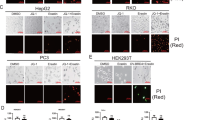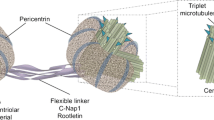Abstract
Noxa is a pro-apoptotic BH3-only member of the Bcl-2 family of proteins that is up-regulated at a transcriptional level by the nuclear protein p53 in response to cellular stresses such as DNA damage or growth factor deprivation. Noxa is able to interact with anti-apoptotic members of the Bcl-2 family and causes release of cytochrome c into the cytosol, leading to the activation of caspases and induction of apoptosis. Here we demonstrate that MG132, a proteasomal inhibitor, rapidly induces Noxa mRNA and protein in two human cell lines, T/C28a and Saos2. The induction of Noxa is associated with a significant reduction in the number of metabolically active cells over the first 24 h of exposure to MG132 and progressive activation of caspase-3, a hallmark of caspase-dependent apoptosis. Partial rescue of the phenotype is observed when cells are transfected with Noxa siRNA prior to treatment with MG132, indicating functional significance of the induction of Noxa. p53 has previously been shown to be non-functional in the T/C28a cell line and is absent by Western blotting in Saos2 cells, suggesting that the induction of Noxa is through a p53 independent mechanism. Western blotting and confocal microscopy showed that total β-catenin protein is increased in both cell lines at the time of Noxa induction, with the bulk of the β-catenin present in the nucleus. Transfection with the Tcf reporter vector pTOPFLASH confirms that treatment with MG132 leads to early increased transcriptional activity of β-catenin in both T/C28a and Saos2 cells. However, although over-expression of transcriptionally active β-catenin in T/C28a cells also induced apoptosis through a p53-independent mechanism, the levels of Noxa protein were unchanged, suggesting that β-catenin mediated signaling and Noxa may play independent roles in MG132 induced apoptosis. In summary, our results demonstrate that MG132 induces the pro-apoptotic protein Noxa via a p53-independent mechanism that leads to caspase-dependent apoptosis. This is the first report showing that treatment with MG132 induces Noxa. This study also provides further evidence for a link between β-catenin mediated signaling and the induction of apoptosis.
Similar content being viewed by others
Abbreviations
- MG132:
-
Z-Leu-Leu-Leu-al
- GSI:
-
γ-secretase tripeptide
- GSK-3β:
-
glycogen synthase akinase 3β
- Tcf:
-
T-cell factor; DAPI, 4′,6-diamidino-2-phenylindole dihydrochloride
- siRNA:
-
small interfering RNA
- PBS:
-
phosphate-buffered saline
- HIF-1α:
-
hypoxia-inducible factor 1α
References
Gross A, McDonnell JM, Korsmeyer SJ. BCL-2 family members and the mitochondria in apoptosis. Genes Dev 1999; 13(15): 1899–1911.
Luo X, Budihardjo I, Zou H, Slaughter C, Wang X. Bid, a Bcl2 interacting protein, mediates cytochrome c release from mitochondria in response to activation of cell surface death receptors. Cell 1998; 94(4): 481–490.
Jurgensmeier JM, Xie Z, Deveraux Q, Ellerby L, Bredesen D, Reed JC. Bax directly induces release of cytochrome c from isolated mitochondria. Proc Natl Acad Sci USA 1998; 95(9): 4997–5002.
Takasawa R, Tanuma S. Sustained release of Smac/DIABLO from mitochondria commits to undergo UVB-induced apoptosis. Apoptosis 2003; 8(3): 291–299.
Heiser D, Labi V, Erlacher M, Villunger A. The Bcl-2 protein family and its role in the development of neoplastic disease. Exp Gerontol 2004; 39(8): 1125–1135.
Cheng EH, Wei MC, Weiler S et al. BCL-2, BCL-X(L) sequester BH3 domain-only molecules preventing BAX- and BAK-mediated mitochondrial apoptosis. Mol Cell 2001; 8(3): 705–711.
Oda E, Ohki R, Murasawa H et al. Noxa, a BH3-only member of the Bcl-2 family and candidate mediator of p53-induced apoptosis. Science 2000; 288(5468): 1053–1058.
Seo YW, Shin JN, Ko KH et al. The molecular mechanism of Noxa-induced mitochondrial dysfunction in p53-mediated cell death. J Biol Chem 2003; 278(48): 48292–48299.
Schuler M, Maurer U, Goldstein JC et al. p53 triggers apoptosis in oncogene-expressing fibroblasts by the induction of Noxa and mitochondrial Bax translocation. Cell Death Differ 2003; 10(4): 451–460.
Shibue T, Takeda K, Oda E et al. Integral role of Noxa in p53-mediated apoptotic response. Genes Dev 2003; 17(18): 2233–2238.
Yakovlev AG, Di Giovanni S, Wang G, Liu W, Stoica B, Faden AI. BOK and NOXA are essential mediators of p53-dependent apoptosis. J Biol Chem 2004; 279(27): 28367–28374.
Qin JZ, Stennett L, Bacon P et al. p53-independent NOXA induction overcomes apoptotic resistance of malignant melanomas. Mol Cancer Ther 2004; 3(8): 895–902.
Hershko T, Ginsberg D. Up-regulation of Bcl-2 homology 3 (BH3)-only proteins by E2F1 mediates apoptosis. J Biol Chem 2004; 279(10): 8627–8634.
Kim JY, Ahn HJ, Ryu JH, Suk K, Park JH. BH3-only protein Noxa is a mediator of hypoxic cell death induced by hypoxia-inducible factor 1alpha. J Exp Med 2004; 199(1): 113–124.
Giuliano M, Lauricella M, Calvaruso G et al. The apoptotic effects and synergistic interaction of sodium butyrate and MG132 in human retinoblastoma Y79 cells. Cancer Res 1999; 59(21): 5586–5595.
MacLaren AP, Chapman RS, Wyllie AH, Watson CJ. p53-dependent apoptosis induced by proteasome inhibition in mammary epithelial cells. Cell Death Differ 2001; 8(3): 210–218.
Emanuele S, Calvaruso G, Lauricella M et al. Apoptosis induced in hepatoblastoma HepG2 cells by the proteasome inhibitor MG132 is associated with hydrogen peroxide production, expression of Bcl-XS and activation of caspase-3. Int J Oncol 2002; 21(4): 857–865.
Nakaso K, Yoshimoto Y, Yano H, Takeshima T, Nakashima K. p53-mediated mitochondrial dysfunction by proteasome inhibition in dopaminergic SH-SY5Y cells. Neurosci Lett 2004; 354(3): 213–216.
Cervello M, Giannitrapani L, La Rosa M et al. Induction of apoptosis by the proteasome inhibitor MG132 in human HCC cells: Possible correlation with specific caspase-dependent cleavage of beta-catenin and inhibition of beta-catenin-mediated transactivation. Int J Mol Med 2004; 13(5): 741–748.
Lauricella M, D’Anneo A, Giuliano M et al. Induction of apoptosis in human osteosarcoma Saos-2 cells by the proteasome inhibitor MG132 and the protective effect of pRb. Cell Death Differ 2003; 10(8): 930–932.
Kim K, Pang KM, Evans M, Hay ED. Overexpression of beta-catenin induces apoptosis independent of its transactivation function with LEF-1 or the involvement of major G1 cell cycle regulators. Mol Biol Cell 2000; 11(10): 3509–3523.
Orford K, Crockett C, Jensen JP, Weissman AM, Byers SW. Serine phosphorylation-regulated ubiquitination and degradation of beta-catenin. J Biol Chem 1997; 272(40): 24735–24738.
Fagotto F, Gluck U, Gumbiner BM. Nuclear localization signal-independent and importin/karyopherin-independent nuclear import of beta-catenin. Curr Biol 1998; 8(4): 181–190.
Henderson BR. Nuclear-cytoplasmic shuttling of APC regulates beta-catenin subcellular localization and turnover. Nat Cell Biol 2000; 2(9): 653–660.
Kuhl M, Wedlich D. Wnt signalling goes nuclear. Bioessays 1997; 19(2): 101–104.
Willert K, Nusse R. Beta-catenin: A key mediator of Wnt signaling. Curr Opin Genet Dev 1998; 8(1): 95–102.
Gustavson MD, Crawford HC, Fingleton B, Matrisian LM. Tcf binding sequence and position determines beta-catenin and Lef-1 responsiveness of MMP-7 promoters. Mol Carcinog 2004; 41(3): 125–139.
Zhang WV, Jullig M, Connolly AR, Stott NS. Early gene response in lithium chloride induced apoptosis. Apoptosis 2005; 10(1): 75–90.
Wessel D, Flugge UI. A method for the quantitative recovery of protein in dilute solution in the presence of detergents and lipids. Anal Biochem 1984; 138(1): 141–143.
Finger F, Schorle C, Zien A, Gebhard P, Goldring MB, Aigner T. Molecular phenotyping of human chondrocyte cell lines T/C-28a2, T/C-28a4, and C-28/I2. Arthritis Rheum 2003; 48(12): 3395–3403.
Hwang SG, Lee HC, Trepel JB, Jeon BH. Anticancer-drug-induced apoptotic cell death in leukemia cells is associated with proteolysis of beta-catenin. Leuk Res 2002; 26(9): 863–871.
Tenev T, Marani M, McNeish I, Lemoine NR. Pro-caspase-3 overexpression sensitises ovarian cancer cells to proteasome inhibitors. Cell Death Differ 2001; 8(3): 256–264.
Chen L, Willis SN, Wei A et al. Differential targeting of pro-survival Bcl-2 proteins by their BH3-only ligands allows complementary apoptotic function. Mol Cell in press.
Villunger A, Michalak EM, Coultas L et al. p53- and drug-induced apoptotic responses mediated by BH3-only proteins puma and noxa. Science 2003; 302(5647): 1036–1038.
Mao CD, Hoang P, DiCorleto PE. Lithium inhibits cell cycle progression and induces stabilization of p53 in bovine aortic endothelial cells. J Biol Chem 2001; 276(28): 26180–26188.
Masuda H, Miller C, Koeffler HP, Battifora H, Cline MJ. Rearrangement of the p53 gene in human osteogenic sarcomas. Proc Natl Acad Sci USA 1987; 84(21): 7716–7719.
Chen PL, Chen YM, Bookstein R, Lee WH. Genetic mechanisms of tumor suppression by the human p53 gene. Science 1990; 250(4987): 1576–1580.
D’Mello SR, Anelli R, Calissano P. Lithium induces apoptosis in immature cerebellar granule cells but promotes survival of mature neurons. Exp Cell Res 1994; 211(2): 332–338.
Madiehe AM, Mampuru LJ, Tyobeka EM. Induction of apoptosis in HL-60 cells by lithium. Biochem Biophys Res Commun 1995; 209(2): 768–774.
van Gijn ME, Snel F, Cleutjens JP, Smits JF, Blankesteijn WM. Overexpression of components of the Frizzled-Dishevelled cascade results in apoptotic cell death, mediated by beta-catenin. Exp Cell Res 2001; 265(1): 46–53.
Tang HR, He Q. Effects of lithium chloride on the proliferation and apoptosis of K562 leukemia cells. Hunan Yi Ke Da Xue Xue Bao 2003; 28(4): 357–360.
Aberle H, Bauer A, Stappert J, Kispert A, Kemler R. beta-catenin is a target for the ubiquitin-proteasome pathway. Embo J 1997; 16(13): 3797–3804.
Fukuda K. Apoptosis-associated cleavage of beta-catenin in human colon cancer and rat hepatoma cells. Int J Biochem Cell Biol 1999; 31(3/4): 519–529.
Author information
Authors and Affiliations
Corresponding author
Rights and permissions
About this article
Cite this article
Jüllig, M., Zhang, W.V., Ferreira, A. et al. MG132 induced apoptosis is associated with p53-independent induction of pro-apoptotic Noxa and transcriptional activity of β-catenin. Apoptosis 11, 627–641 (2006). https://doi.org/10.1007/s10495-006-4990-9
Published:
Issue Date:
DOI: https://doi.org/10.1007/s10495-006-4990-9




